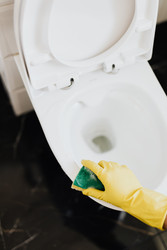How to Handle Moldy Caulk
Jul 11th 2023
No one wants to look at their sink or shower caulking and find black mold lurking there. Savvy homeowners and contractors know that moldy bathroom caulk is not only unpleasant to look at, but it presents health risks. Mold growth can trigger allergies, respiratory problems, skin irritation, and potential infections.
How do you keep mold at bay? How do you remove mold from shower and sink caulk?
Dive into this article to learn how to handle moldy caulk.
Identifying Moldy Caulk
Vigilance and knowledge will help you tackle mold and mildew. You should know what to look for before you can prevent mold. Moldy caulking is a fairly common issue in moisture-prone areas like bathrooms. Look out for these signs:
Discoloration
Dark or black spots along caulk lines indicate mold or mildew presence. Keep in mind that not all discoloration indicates mold. Discoloration can also be caused by dirt, grime, or staining agents. However, if you notice discoloration along with other signs of mold growth, it's more likely to be mold or mildew.
Musty odor
Mold emits a distinct musty smell. If you notice an unpleasant odor near caulked areas, then you might have a mold problem.
Texture changes
Moldy caulk might feel slimy or fuzzy. Run your fingers along caulk lines to check for unusual consistency. Be sure to wash your hands afterward.
Preventing Moldy Caulk
Now that you know how to identify mold, how can you keep your caulk mold-free?
Ventilate the area
Install an exhaust fan in your bathroom to reduce humidity levels. This helps keep moisture low, making it difficult for mold to thrive. Use a fan after hot showers.
Clean regularly
As time goes by, dirt, soap scum, and other organic matter can build up on the caulk, creating an environment that encourages mold growth. Use a soft bristle brush and mild detergent to gently scrub away those substances.
Dry wet surfaces
You must thoroughly dry caulk lines after cleaning or using the shower/bathtub. Use a clean cloth like a towel to wipe down the shower walls, tub, and other wet areas. Don't forget to dry corners and around fixtures.
Get Rid of the Mold or Replace the Caulk?
If prevention fails, you have two choices: remove the mold or replace the caulk completely. If the mold is limited and the caulk is in good shape, mold removal is an option. However, if the caulk is damaged or the mold growth is extensive, it's best to replace the caulk.
How to Remove the Mold
Step 1: Prepare a cleaning solution
Combine equal parts water and bleach in a spray bottle. You could also create a paste using baking soda and water.
Step 2: Apply the solution
Spray the bleach solution directly onto the affected areas or apply the baking soda paste if you’re using that.
Step 3: Wait
Let the cleaning agent sit on the moldy caulk for about 15 minutes to kill and loosen the mold.
Step 4: Gently scrub
Using a soft bristle brush, gently scrub the caulk lines, taking care not to damage the surrounding surfaces. If all goes well, you’ll wipe the mold away. If not, then you might have to repeat the previous steps or, in the worst-case scenario, replace the caulk.
Step 5: Rinse and dry
Rinse the area with clean water to remove residue. Wipe the surfaces dry with a clean cloth. Now’s the time to use a fan to help dry the area.
How to Replace the Caulk
Step 1: Remove the caulk
Carefully cut and scrape away the old caulk using a caulk removal tool or a sharp utility knife.
Step 2: Clean the area
Wipe the surface with a wet cloth to eliminate any remaining debris and mold particles.
Step 3: Apply new caulk
Smoothly apply an even bead of caulk along the joint. For better control and a more precise application, use a caulk gun.
Step 4: Smooth and shape
Wet your finger or a caulk smoothing tool and softly go over the new caulk line.
Step 5: Let it cure
Allow the caulk to cure according to the manufacturer's instructions before getting it wet.
The Best Silicone From Silicone Depot
Mold is a persistent threat that can grow anywhere, indoors or outdoors, causing health issues, financial burdens, and discomfort. Mold not only smells bad but also creates a negative impression on homes, businesses, and properties. Prevention is key. Silicone sealants are commonly used to protect against the unsightly threat.
Where can you get industry-leading sealants?
Silicone Depot is here to help you!
Not only do we have awesome tips to remove mold from shower caulk, but our silicone caulk and accessories can seal the deal for any project. Visit our site or contact us to learn more about our mold-resistant products.

